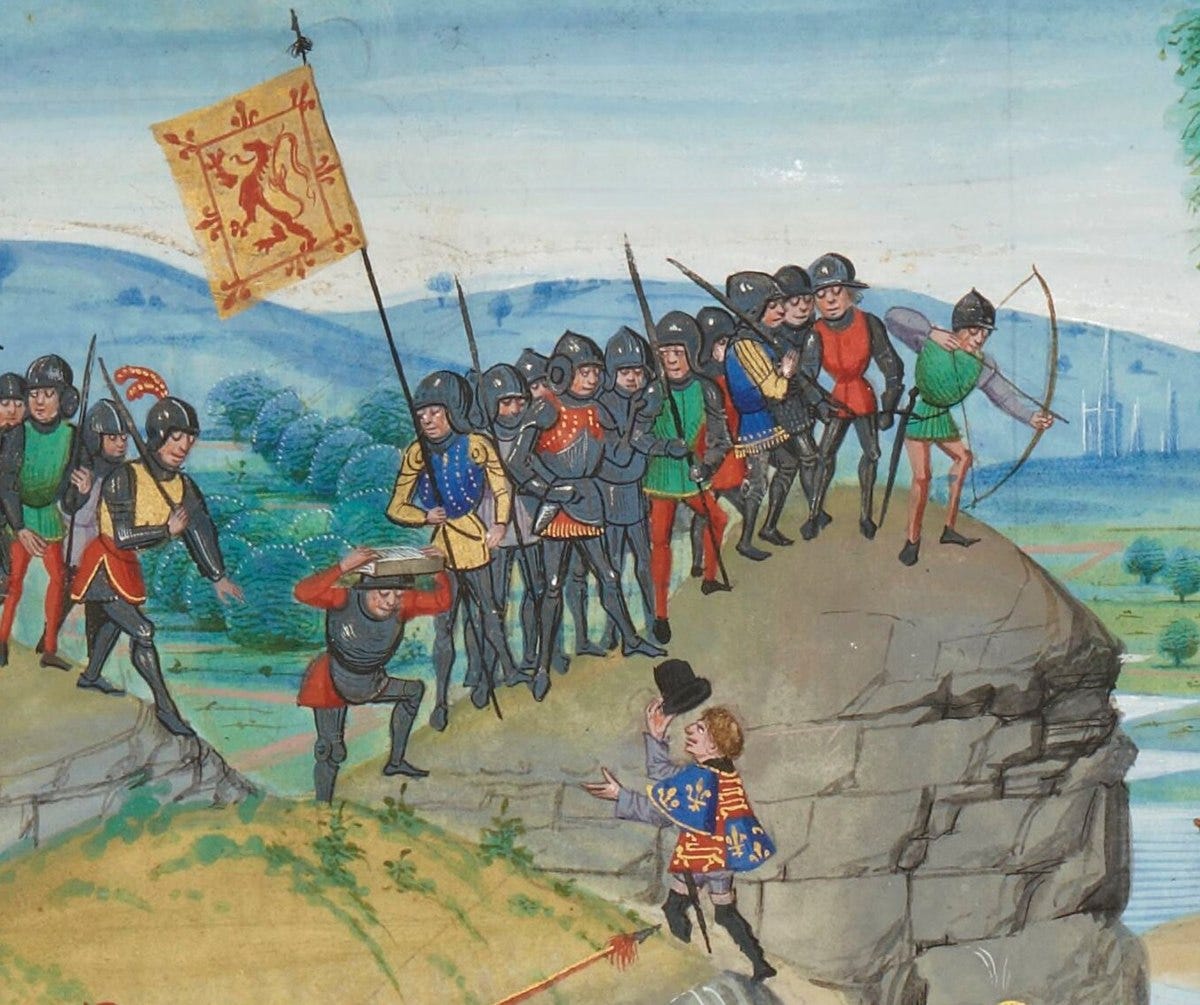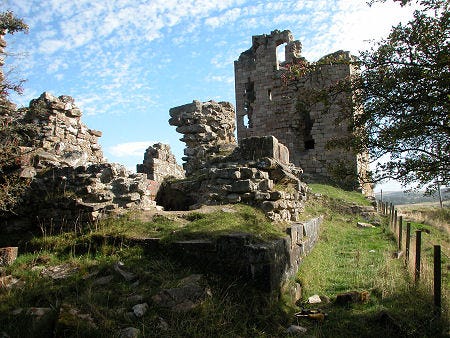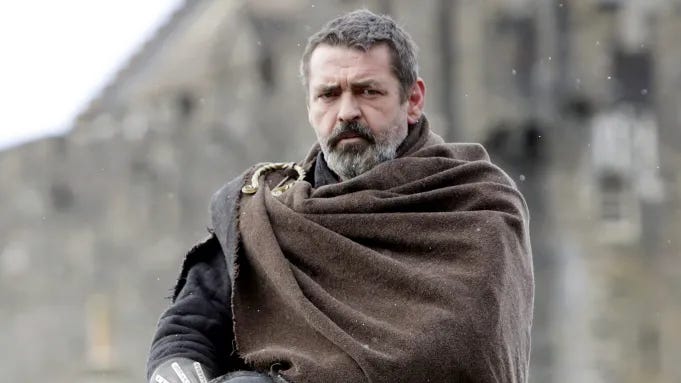Another Scottish thread, perhaps. I look back through my birth father’s line to my paternal fourth great-grandmother’s parentage, Renfrewshire, Scotland-born John Slater (b. 1756) and Jean Barr (b. 1754), to Slater’s own Renfrewshire-born father, David Sclatter (b. 1720). From there, I move up through David Sclatter’s maternal line, to his fifth great-grandparents, and my own potential thirteenth great-grandparents, Sir William Hamilton (c. 1510-1570) and Dame Jean Campbell (c. 1500-1593) of Sanquhar. How much distance can one travel? The Scottish village of Sanquhar, from the Gaelic language An t-Seanchair, meaning “old fort.” A former Royal Burgh on the River Nith in Dumfries and Galloway, Sanquhar is home to the oldest working post office in the world, as well as the ruins of the 13th century Sanquhar Castle, which in its prime saw visitors such as King James VI (James I of England), Sir William Wallace, and Mary, Queen of Scots. Sir William Hamilton, originally known as Hamilton of MacNaristourn, appointed pursemaster (basically, the manager of the king’s finances) for James V in 1524, and the Captain of Edinburgh Castle during the brief Regency of James Hamilton (c. 1519-1575), eventual 1st Duke of Châtellerault and 2nd Earl of Arran, as part of the reign of Mary, Queen of Scots.
The parents of my thirteenth great-grandfather, Sir William Hamilton, were William Hamilton, also of Sanquhar, and Katherine Kennedy, daughter of David Kennedy, 3rd Lord Kennedy and 1st Earl of Cassilis (c. 1463-1513). Lord Kennedy was born in Maybole, Ayrshire, Scotland, and later became a Privy Councillor of King James IV, who created the Earl of Cassilis specifically for him in 1502. Both Lord Kennedy and his King were killed at the Battle of Flodden in 1513, a battle the invading Scots army lost against England as part of the War of the League of Cambrai. Some historians use this battle to mark the end of the Middle Ages in the British Isles, a battle which also prompted the launch of the reign of Scottish James V, or at least initially, through a handful of regents (as he was a year old when his father was killed).
My fifteenth great-grandfather, David Kennedy, 3rd Lord Kennedy, married Agnes Borthwick, daughter of Sir William Borthwick, 3rd Lord Borthwick (d. 1503), a Scottish nobleman and ambassador who was designated Master of the King’s Household, for James III, in 1485. Curiously, Sir William Borthwick’s fourth great-grandfather was Sir William St. Clair, who died before his own father, Henry St. Clair, 7th Baron of Roslin, could pass along his title. William had been one of the knights chosen to join James Douglas, Lord of Douglas, in his foolhardy expedition to Palestine with the heart of Robert the Bruce, leaving William’s son, also named William, to succeed his grandfather. Remember: the expedition never made it to Palestine, all of the knights were killed, and Robert the Bruce’s heart ended up returned to England. [I wrote on the McLennan/Logan connection to that same event here] Must I continue to discover genealogical threads of foolishness? Now I’m just looking for trouble.
According to online sources, David Kennedy’s grandfather was Gilbert Kennedy of Dunure, 1st Lord Kennedy (1405-1489), a son of Sir James Kennedy, Younger of Dunure, and Lady Mary Stewart, herself daughter of Robert III, King of the Scots. It was Lord Gilbert Kennedy, my potential seventeenth great-grandfather, who served as one of six Regents during the early reign of Scottish King James III (1452-1488), after the death of the king’s father, King James II (1430-1460). Rulers die, it would seem, and things simply move along. A lineage of regents. Lord Kennedy’s maternal grandfather, King Robert III, was born John Stewart (1337-1406), holding the titles of Earl of Atholl and Earl of Carrick before ascending the throne at fifty-three, with the death of his father, Robert II, King of Scotland (1316-1390), himself known as the first Stewart monarch. This third Robert, also, was the son of Elizabeth Mure (c. 1320-c. 1355), and Wikipedia offers this curious assemblage:
Elizabeth Mure was said to be born at Rowallan Castle. Her parents were Sir Adam Mure of Rowallan, Ayrshire, and Janet Mure of Pokelly, Ayr, South Ayrshire. Through her father, Elizabeth Mure may be a descendant of Fergus of Galloway (est. 1078 - 1161) and his wife Elizabeth FitzRoy (est. 1109 - 1160), the illegitimate daughter of King Henry I of England, and a member of the House of Normandy. The Muirs/Mures also claim descent from King Fergus Mór of Dál Riata, per the history of Clan Muir.
So much history, so much potential, across such a short measure of sentences. That first King Henry, of course, was the eldest son of William the Conqueror, the first Norman king, and descendant of Rollo, the Viking first ruler of Normandy from 911 to 928. As I’m sure you already know, Dál Riata was the ancient kingdom founded by the legendary (and perhaps apocryphal) Fergus Mór mac Eirc (c. 430-501), across where now lay Argyll in Scotland and a stretch of County Antrim in Northern Island, running from 498 through to 850, after which it became associated with the Gaelic Kingdom of Alba (900-1286). They say Fergus knew St. Patrick, the legendary saint who drove those metaphorical snakes out of Ireland, crushing those local druids as best as he could. St. Patrick, who apparently prophesized great things for Fergus and his many descendants.
Look at me, the potential descendant of Vikings. I probably am dozens of ways, but I don’t believe anything until I can source it. As well, King Robert II was the son of Walter Stewart, 6th High Stewart of Scotland (c. 1296-1327) and Marjorie (c. 1296-c. 1316), firstborn of Robert the Bruce, and the only child born of Robert the Bruce’s first marriage, to Isabella of Mar (c. 1277-1296).
Through this, presuming any of this is correct, Robert the Bruce becomes my twenty-second great-grandfather, which connects me, unfathomably distant, I’m sure, to Scottish actress Tilda Swinton, nineteen generations removed from the Bruce, as the internet provides. Nineteenth cousins, three times removed. How many thousands of others.
A few months back I watched an episode of the genealogical series Who Do You Think You Are, following American actress Hilary Duff, as English genealogist and historian Dr. Nick Barratt moved through a scroll of her ancestry into the big reveal of her direct ancestor, Robert the Bruce. Duff’s response was muted, clearly unaware of who this was. Had she really no idea? Not the first time across these programs I’ve seen an American celebrity in these programs completely unaware of a rather well-known historical figure. I somehow presumed a general awareness of Robert the Bruce to be fairly common in the English-speaking west, but apparently not. The first image that comes to my mind is always the actor Angus Macfadyen, who played the great king in Braveheart (2019), although I’m aware that the historical accuracy of the film a bit mangled. Perhaps I should read up, myself.
In a 2008 piece by Paul Lewis in The Guardian, Lewis cites Dr Katie Stevenson, a lecturer in medieval studies at the University of St Andrews. “Claims of Scottish medieval ancestry, she said, are virtually impossible to prove unless traced through rare documentation. ‘There are no records of that nature. Any historian will tell you that it’s virtually impossible to prove ancestry through the middle ages.’” Writing around ancestry, the article was focused on American senator John McCain, who was then working a presidential bid, and his published claim to be a descendant of Robert the Bruce. Quoting Dr. Bruce Durie, academic manager, genealogical studies at the University of Strathclyde, Lewis continues:
Durie pointed out that Robert I was believed to have had up to a dozen children – several illegitimately. Basic calculations suggested there could be as many as 200 million people distantly related to him. “In that sense McCain probably is descended from Bruce. So am I. So are you. So is everyone.”
A few years later, The Guardian published “So you’re related to Charlemagne? You and every other living European…” by Adam Rutherford, a 2015 article that leans into similar conversations around the contemporary obsession with DNA ancestry:
But we are all special, which means none of us are. If you’re vaguely of European extraction, you are also the fruits of Charlemagne’s prodigious loins. A fecund ruler, he sired at least 18 children by motley wives and concubines, including Charles the Younger, Pippin the Hunchback, Drogo of Metz, Hruodrud, Ruodhaid, and not forgetting Hugh.
This is merely a numbers game. You have two parents, four grandparents, eight great-grandparents, and so on. But this ancestral expansion is not borne back ceaselessly into the past. If it were, your family tree when Charlemagne was Le Grand Fromage would harbour more than a billion ancestors – more people than were alive then.
[See my Charlemagne piece here] How I’ve been chasing these genealogical distances as though they were rarity, misunderstanding that the further I move up a particular line, the more universal the connection. If nothing else, how these genetic campaigns might provide further folk to explore history. The amount I’ve researched due to a familial connection, however tangential. Perhaps this is a good thing. One might say I don’t care who you claim, but that statement imperfect as well. There are better ways. Read history! Where am I going with this?
From this same genealogical thread emerges my third great-grandmother, Helen Eleanor McPherson, who was born at the end of 1809 in Inverkip, Renfrewshire, Scotland, only to die at sea in 1844 during immigration, leaving her husband and how many children to land in Upper Canada. The records, at least so far as I’ve found, offer little. Tell me of her, would you.







The Bruce!